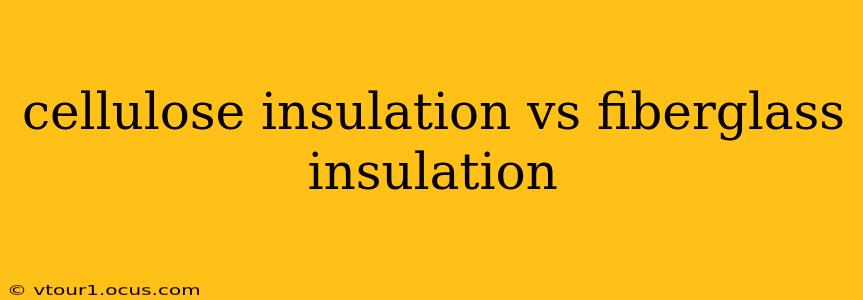Choosing the right insulation for your home is a crucial decision impacting energy efficiency, comfort, and long-term costs. Two popular options are cellulose and fiberglass insulation, each with its own set of advantages and disadvantages. This comprehensive guide will delve into the key differences to help you make an informed choice.
What is Cellulose Insulation?
Cellulose insulation is a recycled paper product treated with borates for fire resistance and pest deterrence. It's a loose-fill material, meaning it's blown into walls and attics using specialized equipment. Its fluffy texture allows it to settle effectively into hard-to-reach spaces, creating a continuous insulating layer with minimal gaps.
What is Fiberglass Insulation?
Fiberglass insulation, on the other hand, is made from glass fibers bonded together. It comes in various forms, including batts (rolls), loose-fill, and rigid boards. Fiberglass batts are commonly used in wall cavities and attics, while rigid boards are often used for exterior sheathing. Loose-fill fiberglass is similar in application to cellulose.
Cellulose Insulation vs. Fiberglass Insulation: A Detailed Comparison
| Feature | Cellulose Insulation | Fiberglass Insulation |
|---|---|---|
| Material | Recycled paper, treated with borates | Glass fibers |
| Installation | Loose-fill, blown into place | Batts (rolls), loose-fill, rigid boards |
| R-Value | Comparable to fiberglass, varies by density | Varies depending on type and thickness |
| Cost | Often less expensive upfront | Can be more expensive upfront |
| Sustainability | Highly sustainable, uses recycled materials | Less sustainable, energy-intensive manufacturing |
| Moisture Resistance | Good moisture absorption, can help regulate humidity | Less moisture resistant, can absorb moisture |
| Fire Resistance | Naturally fire-resistant due to borate treatment | Treated with fire retardants, but can still burn |
| Air Sealing | Excellent air sealing properties | Good air sealing with proper installation |
| Installation Difficulty | Requires specialized equipment | Easier to install batts, loose-fill requires equipment |
| Health Concerns | Minimal health concerns, potential for dust | Can cause skin irritation, may release fibers |
What are the advantages of cellulose insulation?
Cellulose insulation boasts several advantages:
- High R-value per inch: It provides excellent thermal resistance for its thickness, contributing to significant energy savings.
- Superior air sealing: Its loose-fill nature effectively seals air gaps, reducing drafts and energy loss.
- Eco-friendly: Made from recycled paper, it promotes sustainability.
- Moisture absorption: Cellulose can help regulate humidity levels within your home, minimizing moisture-related issues.
- Fire resistant: The borate treatment significantly enhances fire resistance.
What are the advantages of fiberglass insulation?
Fiberglass insulation offers its own set of advantages:
- Wide availability: Readily available at most home improvement stores.
- Ease of installation (batts): Batt insulation is relatively easy to install for DIYers.
- Various forms: Offers flexibility in choosing the right type for different applications.
- Cost-effective (in some cases): Depending on the region and type, fiberglass can be less expensive than cellulose in certain situations.
What is the difference in cost between cellulose and fiberglass insulation?
The cost difference between cellulose and fiberglass insulation varies depending on location, installer, and project specifics. Generally, cellulose insulation tends to be less expensive upfront due to the lower cost of the material itself. However, the installation cost may be higher due to the specialized equipment required. Fiberglass insulation, particularly batts, can be more affordable for DIY projects, but professional installation might be comparable or even exceed the cost of cellulose installation.
Which insulation is better for soundproofing?
Both cellulose and fiberglass insulation offer some degree of sound dampening. However, cellulose's denser packing and ability to fill irregular spaces often provide slightly better soundproofing properties. The effectiveness of both materials will also depend on the overall construction of your home and the presence of other sound-reducing elements.
Which insulation is better for moisture control?
Cellulose insulation generally shows better moisture absorption and control capabilities compared to fiberglass. This feature is attributed to cellulose's higher moisture absorption capacity. However, proper ventilation remains crucial regardless of the chosen insulation material to prevent moisture build-up.
Is cellulose insulation safe?
Cellulose insulation is generally considered safe. The borate treatment makes it fire-resistant and pest-deterrent. Minimal health risks are associated with its use; however, it's advisable to wear a mask during installation to avoid inhaling dust.
Which insulation is best for the attic?
The best insulation for your attic depends on your specific needs and preferences. Both cellulose and fiberglass are suitable for attics, offering excellent thermal performance. Cellulose's air-sealing properties are particularly beneficial for attics, often prone to air leaks. However, fiberglass batts are often chosen for their ease of installation if you're opting for a DIY approach.
Conclusion: Making the Right Choice
The best insulation for your home depends on your specific needs, budget, and the type of project. Consider factors like R-value requirements, installation costs, sustainability goals, and moisture control preferences. Consulting with a qualified insulation contractor is highly recommended to assess your home's unique needs and select the most appropriate option. They can help you navigate the complexities of insulation choices and ensure a proper installation for optimal energy efficiency and comfort.
